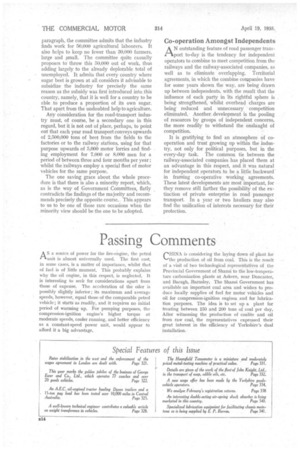Passing Comments
Page 24

Page 25

If you've noticed an error in this article please click here to report it so we can fix it.
AS a source of power for the fire-engine, the petrol unit is almost universally used. The first cost, in some cases, is a matter of importance, whilst that of fuel is of little moment. This probably explains why the oil engine, in this respect, is neglected. It is interesting to seek for considerations apart from those of expense. The acceleration of the oiler is possibly slightly inferior ; its maximum and average speeds, however, equal those of the comparable petrol vehicle; it starts as readily, and it requires no initial period of warming up. For pumping purposes; the compression-ignition engine's higher torque at moderate speeds, cooler running, and better efficiency as a constant-speed power unit, would appear to afford it a big advantage. CHINA is considering the laying down of plant for the production of oil from coal. This is the result of a visit of two technological representatives of the Provincial Government of Shansi to the low-temperature carbonization plants at Askern, near Doncaster, and Bar ugh, Barnsley. The Shansi Government has available an important coal area and wishes to produce locally supplies of fuel for motor vehicles and oil for compression-ignition engines and for lubrication purposes. The idea is to set up a plant for treating between 150 and 200 tons of coal per day. After witnessing the production of coalite and oil from raw coal, the representatives expressed their great interest in the efficiency of Yorkshire's dual installation. nOE'S the haulage business engendcr pessimism? An applicant for a licence for an extra lorry recently told the South Wales Commissioners, at Bridgend, that he had contracts that would employ this extra :orry for eight months of the year. Asked what he ould do with the lorry during the other four months, the applicant said that he " didn't know yet." "I might," he added, "be dead by then." The licence was granted.
ALL this talk and publicity regarding safety on the roads is apt to detract from the importance of the much greater number of accidents in industry, and efforts to reduce these should likewise be appreciated. The figures issued by the National Safety First Association show that the automobile industry, generally, has a good record in this respect, and amongst the safest factories is the Ford Works at Dagenham, which is shown to have the low accident rate of .79 per 100,000 hours worked, compared with the average rate of 1.53 for the industry as a whole; in other words, 126,581 hours were worked there for every accident that occurred. Considering that this factory includes a blast furnace, a chemical works and docks, where the accident hazards are much higher than in motor manufacturing, the ex
cellent figure is remarkable. One reason is that there is no shafting or belting, practically every machine in the works being driven by its own electric motor.
THE chairman of Doncaster's municipal transport undertaking, Alderman H. M. Marshall, has ,a complaint. It is' that even some of the residents of Doncaster go out of their way to inform peop7e coming to the Doncaster races that, whereas if they use the racecourse service of buses the fare will cost them 6d., they can travel for three halfpence on another service which runs at the other side of the town but goes very near the racecourse. Ratepayers even go out of their way to rob themselves, says Alderman Marshall.
PDARTS is reconstructing on the site of the fortifications which have been in the process of demolition during 12 years. The material derived from walls and earthworks has been used for filling in trenches, and advantage is being taken of the levelling of the 59 gates to relieve the congestion of traffic caused by the narrow exits. The roads have been widened and provided where necessary with a surfacing of small
setts on a concrete foundation. The old military system of boulevards has been incorporated in the circular route first contemplated in 1861. This is 130 ft. wide, except to the west, where good parallel routes exist. Six traffic lanes will, as a rule, be provided. Five vehicle subways are in use, and 17 are under construction. The width of these will be limited to 36 ft. for four 9-ft. traffic lanes. Photoelectric cells will warn drivers of vehicles over tits height limit.




















































































